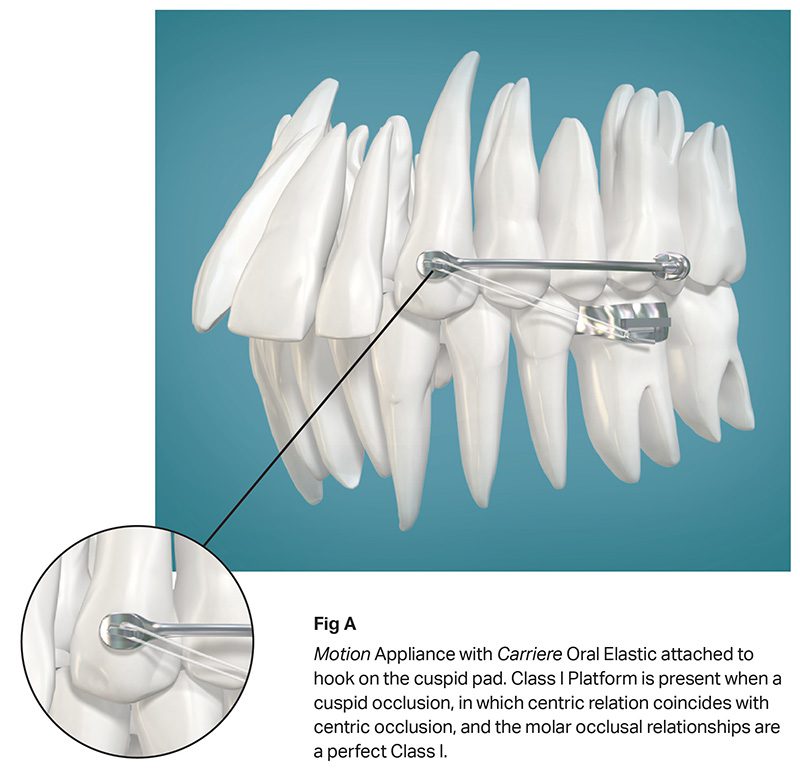CARRIERE Motion class II appliance Turn Class II Into Simple Class I Patients
A huge move in the right direction for orthodontics. To limit extractions and to turn difficult Class II patients into simpler Class I patients is a dream come true for you and your patients. With its sleek, aesthetic, and non-invasive design, the Motion Class II Correction Appliance provides greater comfort and shortens treatment time by up to four months. Delivering a natural, gentle, and uniform force for distal molar movement with controlled rotation and tipping correction before brackets or other appliances are placed, the Motion Appliance solves complex problems almost effortlessly.
The Motion Philosophy
Fast
Shortens overall treatment time by up to four months as it treats Class II correction at the beginning of the orthodontic treatment, when there are no competing forces in the mouth caused by brackets or other appliances. A Class II correction can usually be completed in an average of 3-4 months.
Natural
Mimicking a human hip ball-socket joint, the Motion Appliance allows the first molar to rotate and upright in its natural and correct finishing position, producing a continuous, natural, and uniform force for distal molar movement with controlled rotation and tipping correction. Built-in stops engineered in the appliance prevent the molars from over-rotating and the crowns from distal tipping. The Motion Appliances low forces are biologically compatible during the Class II treatment. Gentle. The low force of the Motion Appliance is gentle on your patients, and its low profile design is very comfortable to wear. By treating the Class II platform first, it simplifies the entire treatment for you, and provides greater comfort for your patients.
Going from Class II to Class I has never been easier
The Motion is a direct bond appliance that attaches to the maxillary canine and first permanent molar, providing a simple procedure for turning complex Class II patients into a Class I platform. Once a Class I condition is achieved, malocclusions become easier to treat and can be finished with your preferred orthodontic technique. Since there are no competing forces in the mouth when using this appliance, average Class II correction can usually be achieved in just three to four months. Eliminates wire changes and the distorting collateral forces that appear with every wire activation used in traditional methods. Minimises root resorption. Patients are treated faster with less discomfort. High level of patient compliance as the appliance is aesthetically pleasing, and used during the initial phase of treatment when patient’s motivation is still high.
How it Works
- Corrects the posterior occlusion to an ideal Class I platform first by rotating and uprighting the maxillary first molars while distalizing the posterior segment, from canine or premolar to molars, into a perfect occlusion.
- Simultaneously produces a light, uniform force for distal molar movement.
- Independently moves each posterior segment, from canine or premolar to molar, as a unit.
- Used at the beginning of treatment when there are no competing forces in the mouth allows the distalization of the molars and premolars from 3 to 6mm range, on average.
Indications
- Most effective in treating Class II symmetrical and asymmetrical malocclusions without the need for extractions.
- May also be used in many Class I patients with mesially positioned maxillary molars.
- Growing patients are ideal, but adults may be treated as well.
- Mixed dentition Class II patients with fully erupted molars are candidates for Phase 1 treatment to establish a Class I platform.
Ease of Placement
The Motion Appliance is placed on the maxillary arch, but requires a solid and consistent source of anchorage in the mandibular arch to avoid protrusion of the lower incisors (a lower Essix Appliance with direct bonded tubes on lower molars, a passive lingual arch, a full mandibular fixed appliance, or mini-screws). Once the appliance is bonded, the Carriere Oral Elastics are attached from the mandibular molar to the hook of the maxillary cuspid of the Motion Appliance to activate.
The Movement Created by the Motion Appliance
Bodily distalizes the maxillary posterior segments as a block while correcting upper first molar rotation and uprighting. The posterior portion of the Motion Appliance accomplishes three types of molar movement:
1. Uprighting of the crown, if it is mesially inclined (Fig. 01). Once the molar has been uprighted, the articulation of the ball with the socket prevents distal tipping.
2. Distal rotation around the palatal root. When the maxillary first molar is mesially rotated around the palatal root, the molar occlusion may appear to be Class II, while in reality it is Class I with the canines in a cusp-to-cusp relationship
(Fig. 02). When the molar has been de-rotated, the shoulder of the posterior base contacts the mesial arm to prevent over-rotation.
3. Distal displacement without concurrent distal tipping of the crown.
Fig 01 – Provides controlled molar rotation and uprighting.
Fig 02 – The maxillary molars are distalized and rotated, providing a platform for maxillary canines to occlude in a Class I relationship.
Fig 03 – With mesially rotated molars, cuspids cannot occlude in Class I relationship.
Fig 04 – Independently moves each posterior segment, from canine or premolar to molar, as a unit.






